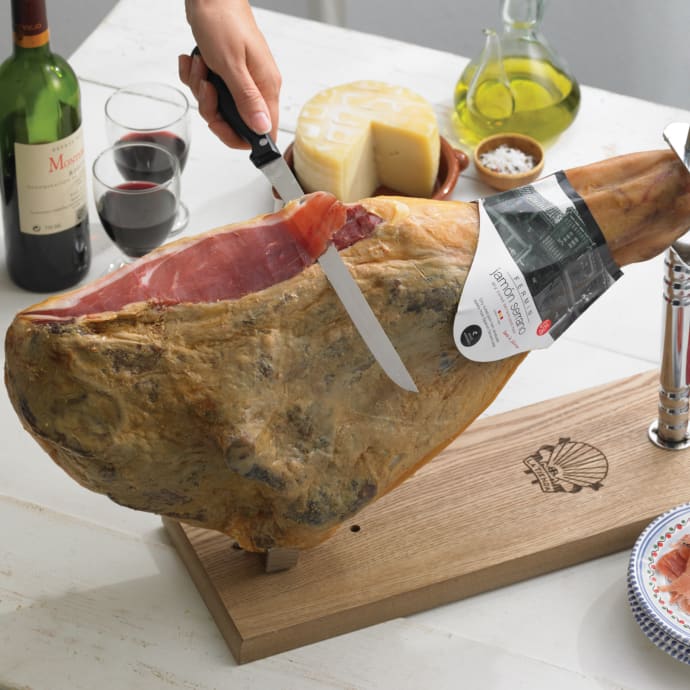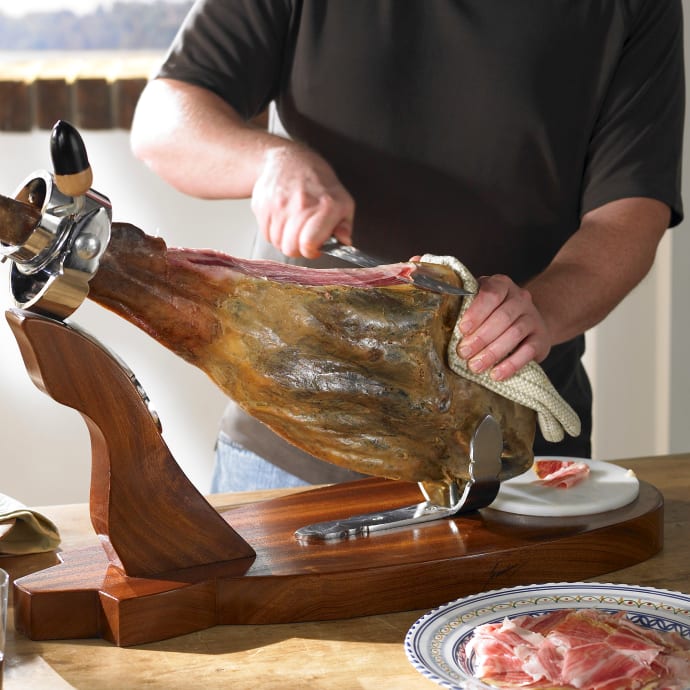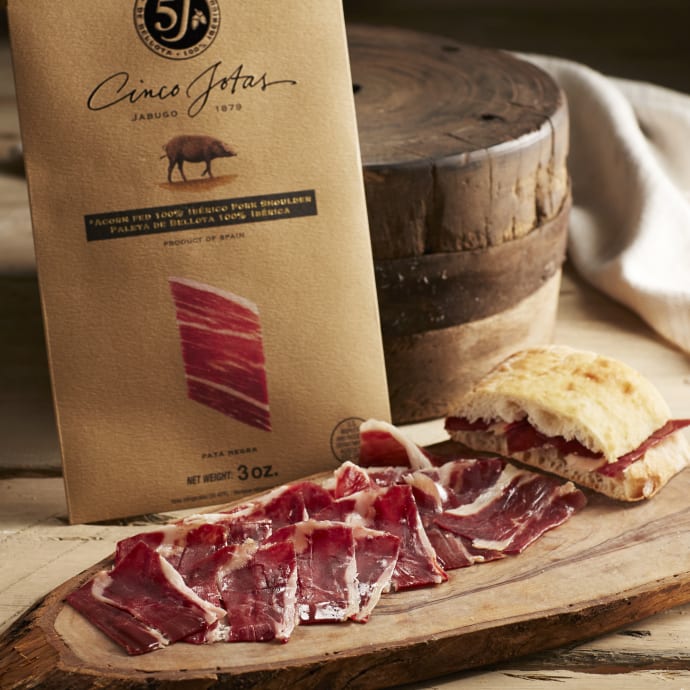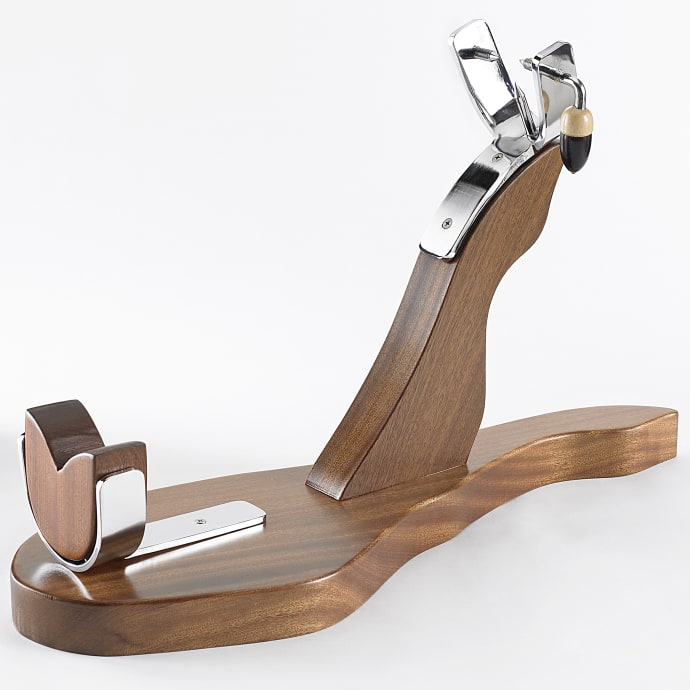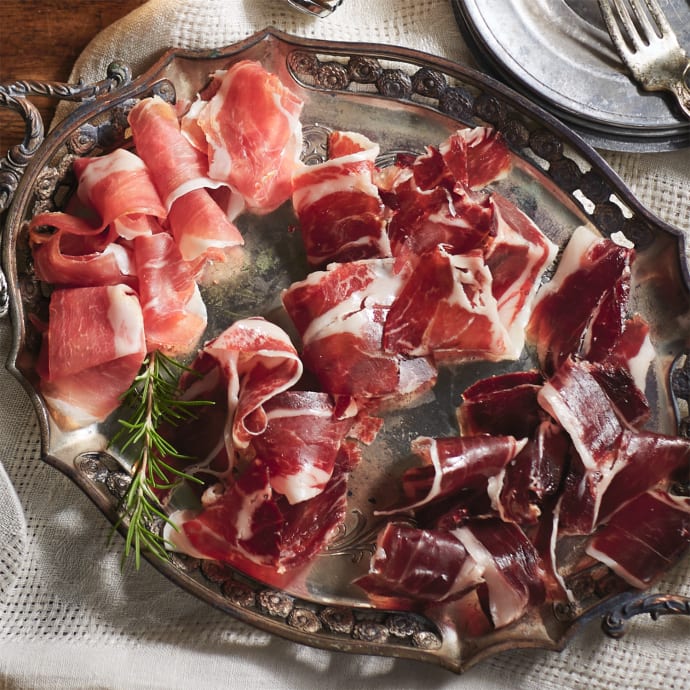
delicioso! a ham with taste (for mucho dinero)
The Virginian Pilot
-
March 1, 2008
Lorraine Eaton
This week, hams at local groceries can be had for less than $1 a pound. Drive over to La Tienda, a Spanish market just west of Williamsburg, and you can get a whole ham for a few hundred bucks.
“Do you mean the million-dollar ham? Or the trilliondollar ham?” Don Harris joked on a recent afternoon when we arrived to experience the high-priced hog at his family’s small market in Toano.
What Harris really meant was:
Did we want the Fermin jamon serrano?
What it is - That’s literally “mountain ham” from a “white” breed of pig similar to the porkers that please American palates. These are dry cured – without smoke and most of the salt we Southerners are used to – in the Spanish mountains for 15 months. The cost A whole bone-in ham costs $269.
Or did we mean the jamon Iberico?
What it is - This “noble” breed of black-hoofed, black-skinned pig is a native Spaniard. Harris’ hams hail from the site of a medieval mountaintop village. The tall, long-snouted, skinny-legged swine gorges on grains and corn and develops a layer of fat sometimes 2 inches thick. More fat means the hams can be cured longer, resulting in more intensity of flavor. The dry-curing process takes up to three years. The cost A whole, bone-in ham runs $800.
Or did we mean the jamon Iberico de bellota?
What it is - This is the culinary king of Spain. Like its brethren that lacks the bellota surname, this Iberico pig also starts with a diet of grain and corn. But clans of bellota-to-be are raised together, and a few months before slaughter they are turned out into the “dehesa,” Spain’s prized forests of Holm oak and cork trees. The pigs forage endlessly on the trees’ acorns, or la bellota, fatten up and develop a rich, purplish, marbled, slightly salty meat tinged with a nutty sweetness. The cost A boneless ham runs about $1,400.
Want a whole jamon Iberico de bellota? Get in line.
Harris has a waiting list of 300 people from across the country who have plunked down a $200 deposit. The hams are expected to arrive in July, although quarter-pound packages of hand-sliced Iberico de bellota paleta, meat from the shoulder, are now available at La Tienda’s market and its online store, www.tienda.com, for a mere $34.50.
Harris, a retired Navy man, fell in love with Spain years ago. He and his family started La Tienda a decade ago, and today it’s a thriving online market for epicures with a taste for Spain’s finest. He’s worked for years to get the prized Iberico hams into the United States. USDA rules prohibited Iberico’s import, but finally a slaughterhouse in Spain secured USDA approval and the first Iberico ham arrived in the States in December.
“We’ve been working on this for 10 years,” Harris said. “We had to get it. It’s the signature product of Spain.”
While Americans might balk at the hefty cost, Harris listed a litany of reasons for the fat price tag. The blood of the pigs is tested for pedigree – only those with a certain percentage of Iberico blood will be finished as bellota. The pigs live a longer life compared to domestic pigs and therefore cost more to raise. Mature pigs are tested to assure that the animal has acquired a certain percentage of oleic acid from the acorns. The dehesa where the pig families graze on acorns is being eyed by developers, making it more expensive to maintain the forest pastures.
In addition, demand has increased. French, Japanese and American epicures have become jamon junkies, lusting for a taste of the amber-marbled meat that glistens when sliced. And a healthy Spanish economy means that more Spaniards can afford their country’s best jamon.
The jamon Iberico de bellota destined for La Tienda spend their last day listening to Mozart. The next morning, they get a hot shower and are gassed; it’s about as stress-free a death as possible, Harris said.
“Anxious pigs will produce things that affect the flavor of the meat,” he said. “If you pay $100 a pound for meat, that’s relevant. It’s irrelevant for $2-a-pound pork chops.”
Curing can take from three to five years. Then there’s the Euro-vs.-dollar issue.
“They aren’t fleecing us,” Harris said.
But this might not make a main course ham for your traditional Easter table. In Spain, whole hams resting on special stands are left on kitchen countertops. Friends and family slice thin wafers at their leisure; think proscuitto, not a main course. A thick slice of fat or an olive oil-soaked rag is placed over the cut to stop the meat from drying out.
Harris sells ham holders, too.
One of his wait-listed customers recently called about the $69 ham holder on his Web site.
You don’t think I want to display my $1,400 ham in a $50 holder? she asked.
The solution is on display in the La Tienda market, a gleaming mahogany stand with an apparatus that turns the ham, eliminating that muss and bother. The price: $950.
We already knew that the oldest ham hails from Smithfield. Now, we know that the most expensive hams are just a Sunday drive away.
Lorraine Eaton, (757) 446-2697,
This week, hams at local groceries can be had for less than $1 a pound. Drive over to La Tienda, a Spanish market just west of Williamsburg, and you can get a whole ham for a few hundred bucks.
“Do you mean the million-dollar ham? Or the trilliondollar ham?” Don Harris joked on a recent afternoon when we arrived to experience the high-priced hog at his family’s small market in Toano.
What Harris really meant was:
Did we want the Fermin jamon serrano?
What it is - That’s literally “mountain ham” from a “white” breed of pig similar to the porkers that please American palates. These are dry cured – without smoke and most of the salt we Southerners are used to – in the Spanish mountains for 15 months. The cost A whole bone-in ham costs $269.
Or did we mean the jamon Iberico?
What it is - This “noble” breed of black-hoofed, black-skinned pig is a native Spaniard. Harris’ hams hail from the site of a medieval mountaintop village. The tall, long-snouted, skinny-legged swine gorges on grains and corn and develops a layer of fat sometimes 2 inches thick. More fat means the hams can be cured longer, resulting in more intensity of flavor. The dry-curing process takes up to three years. The cost A whole, bone-in ham runs $800.
Or did we mean the jamon Iberico de bellota?
What it is - This is the culinary king of Spain. Like its brethren that lacks the bellota surname, this Iberico pig also starts with a diet of grain and corn. But clans of bellota-to-be are raised together, and a few months before slaughter they are turned out into the “dehesa,” Spain’s prized forests of Holm oak and cork trees. The pigs forage endlessly on the trees’ acorns, or la bellota, fatten up and develop a rich, purplish, marbled, slightly salty meat tinged with a nutty sweetness. The cost A boneless ham runs about $1,400.
Want a whole jamon Iberico de bellota? Get in line.
Harris has a waiting list of 300 people from across the country who have plunked down a $200 deposit. The hams are expected to arrive in July, although quarter-pound packages of hand-sliced Iberico de bellota paleta, meat from the shoulder, are now available at La Tienda’s market and its online store, www.tienda.com, for a mere $34.50.
Harris, a retired Navy man, fell in love with Spain years ago. He and his family started La Tienda a decade ago, and today it’s a thriving online market for epicures with a taste for Spain’s finest. He’s worked for years to get the prized Iberico hams into the United States. USDA rules prohibited Iberico’s import, but finally a slaughterhouse in Spain secured USDA approval and the first Iberico ham arrived in the States in December.
“We’ve been working on this for 10 years,” Harris said. “We had to get it. It’s the signature product of Spain.”
While Americans might balk at the hefty cost, Harris listed a litany of reasons for the fat price tag. The blood of the pigs is tested for pedigree – only those with a certain percentage of Iberico blood will be finished as bellota. The pigs live a longer life compared to domestic pigs and therefore cost more to raise. Mature pigs are tested to assure that the animal has acquired a certain percentage of oleic acid from the acorns. The dehesa where the pig families graze on acorns is being eyed by developers, making it more expensive to maintain the forest pastures.
In addition, demand has increased. French, Japanese and American epicures have become jamon junkies, lusting for a taste of the amber-marbled meat that glistens when sliced. And a healthy Spanish economy means that more Spaniards can afford their country’s best jamon.
The jamon Iberico de bellota destined for La Tienda spend their last day listening to Mozart. The next morning, they get a hot shower and are gassed; it’s about as stress-free a death as possible, Harris said.
“Anxious pigs will produce things that affect the flavor of the meat,” he said. “If you pay $100 a pound for meat, that’s relevant. It’s irrelevant for $2-a-pound pork chops.”
Curing can take from three to five years. Then there’s the Euro-vs.-dollar issue.
“They aren’t fleecing us,” Harris said.
But this might not make a main course ham for your traditional Easter table. In Spain, whole hams resting on special stands are left on kitchen countertops. Friends and family slice thin wafers at their leisure; think proscuitto, not a main course. A thick slice of fat or an olive oil-soaked rag is placed over the cut to stop the meat from drying out.
Harris sells ham holders, too.
One of his wait-listed customers recently called about the $69 ham holder on his Web site.
You don’t think I want to display my $1,400 ham in a $50 holder? she asked.
The solution is on display in the La Tienda market, a gleaming mahogany stand with an apparatus that turns the ham, eliminating that muss and bother. The price: $950.
We already knew that the oldest ham hails from Smithfield. Now, we know that the most expensive hams are just a Sunday drive away.
Lorraine Eaton, (757) 446-2697,
Other Press
Featured Products

Serrano Bone-In Jamón - Fermín - FREE SHIPPING
JM-32
$439.00 $389.00

Ibérico Bone-In Jamón - Fermin - FREE SHIPPING!
JM-11
$699.00$699.00

100% Ibérico de Bellota Bone-In Jamón - Cinco Jotas - FREE SHIPPING!
JM-106
$1,499.00$1,499.00

100% Ibérico de Bellota Sliced Shoulder - Cinco Jotas
JM-111
$49.00$49.00

Solid Hardwood Deluxe Ham Holder - Salamanca
JH-02
$799.00$799.00

Serrano, Ibérico and Ibérico de Bellota Sliced Jamón Tasting Trio
JM-25
$75.00$75.00

Ibérico de Bellota Sliced Jamón - Peregrino
JM-52
$42.00$42.00

